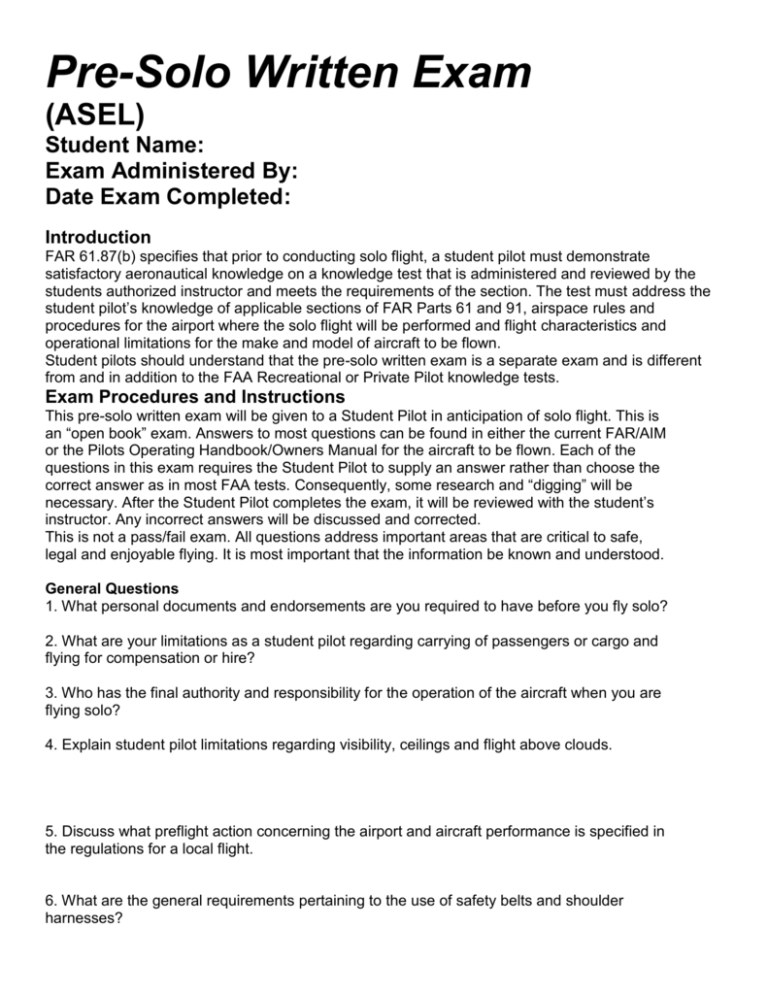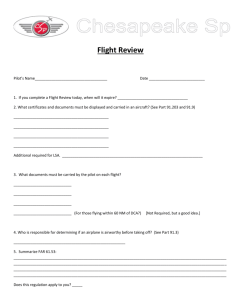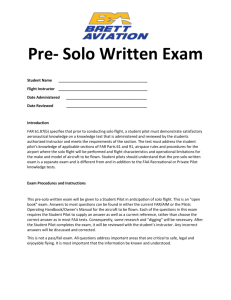DOCX Format
advertisement

Pre-Solo Written Exam (ASEL) Student Name: Exam Administered By: Date Exam Completed: Introduction FAR 61.87(b) specifies that prior to conducting solo flight, a student pilot must demonstrate satisfactory aeronautical knowledge on a knowledge test that is administered and reviewed by the students authorized instructor and meets the requirements of the section. The test must address the student pilot’s knowledge of applicable sections of FAR Parts 61 and 91, airspace rules and procedures for the airport where the solo flight will be performed and flight characteristics and operational limitations for the make and model of aircraft to be flown. Student pilots should understand that the pre-solo written exam is a separate exam and is different from and in addition to the FAA Recreational or Private Pilot knowledge tests. Exam Procedures and Instructions This pre-solo written exam will be given to a Student Pilot in anticipation of solo flight. This is an “open book” exam. Answers to most questions can be found in either the current FAR/AIM or the Pilots Operating Handbook/Owners Manual for the aircraft to be flown. Each of the questions in this exam requires the Student Pilot to supply an answer rather than choose the correct answer as in most FAA tests. Consequently, some research and “digging” will be necessary. After the Student Pilot completes the exam, it will be reviewed with the student’s instructor. Any incorrect answers will be discussed and corrected. This is not a pass/fail exam. All questions address important areas that are critical to safe, legal and enjoyable flying. It is most important that the information be known and understood. General Questions 1. What personal documents and endorsements are you required to have before you fly solo? 2. What are your limitations as a student pilot regarding carrying of passengers or cargo and flying for compensation or hire? 3. Who has the final authority and responsibility for the operation of the aircraft when you are flying solo? 4. Explain student pilot limitations regarding visibility, ceilings and flight above clouds. 5. Discuss what preflight action concerning the airport and aircraft performance is specified in the regulations for a local flight. 6. What are the general requirements pertaining to the use of safety belts and shoulder harnesses? 7. What is the minimum fuel reserve for day VFR flight and on what cruise speed is the fuel reserve based? 8. What aircraft certificates and documents must be on board when you are flying solo? 9. Discuss the right-of-way rules regarding overtaking another aircraft, approaching head-on and another aircraft converging from the side. 10. Who has the right-of-way when two aircraft are on final approach to land at the same time? 11. Discuss the regulations regarding the consumption of alcohol and operating an aircraft. 12. At and around KRBD, where is an operating mode C transponder required? 13. Except when necessary for takeoffs and landings, what are the minimum safe altitudes at all times, when flying over congested areas, and other than congested areas? 14. List at least three sources for the local altimeter setting at an airport and another alternative if none is available. 15. When practicing steep turns, stalls and maneuvering during slow flight, the entry altitude must allow a recovery to be completed no lower than how many feet AGL? 16. When is a go-around appropriate? 17. Discuss the steps in the go-around process. 18. What general steps should you follow after an engine failure in flight? 19. During flight, you begin to see a gradual decrease in power. What is a likely cause and what should be done to remedy the situation? 20. During engine run-up, you cause rocks, debris and propeller blast to be directed toward another aircraft or person. Could this be considered careless or reckless operation of an aircraft? 21. What altitudes should you use when operating VFR in level cruising flight at more than 3000 feet AGL and what determines those altitudes? 22. What is the emergency frequency? Aircraft Questions 1. List the minimum equipment and instruments that must be working properly in your aircraft for day VFR flight. 2. Fill in the V-speed definitions and the corresponding speed for your training airplane. Definition Speed Vso Vs1 Vx Vy Vfe Va Vno Vne 3. What is the best glide speed for your training airplane? KIAS 4. Describe the changes in Vg and Va with changes in the gross weight of an aircraft. 5. What flap settings should be used in your training airplane for the following operations? Takeoff: Normal Short Field Soft Field Landing: Normal Short Field Soft Field 6. Describe any limitations on flap use in your training airplane. 7. What grade or grades of fuel can be safely used in your aircraft? What are the colors of the recommended fuels? What happens to the color if two grades are mixed? 8. What are the minimum and maximum oil capacities for your training airplane? 9. Under what circumstances should you use carburetor heat? 10. If during a flight, you experience carburetor ice and full carburetor heat is applied, what changes in engine performance would you expect? 11. Under what circumstances could a spin occur in your training aircraft? 12. Describe the spin recovery procedures for your training aircraft. 13. What is the stall speed of your training airplane in a 60 degree bank with flaps up? Airport/Airspace 1. What are the traffic patterns for each runway at your home airport. What is the MSL altitude for the traffic pattern? 2. How do you enter and exit the traffic pattern at your airport. What radio communications are required? 3. Describe how you would approach and enter the traffic pattern at an uncontrolled airport. 4. What radio calls are recommended as you approach and fly in the traffic pattern at an uncontrolled airport? 5. What are the typical dimensions of Class D airspace and what requirement(s) must be met prior to entry? 6. What is CTAF? Explain the CTAF procedures at your home airport. 7. How can you tell if a runway is closed? 8. If you receive ATC instructions that you do not understand or feel may compromise safety, what should you do? 9. What is the meaning of each of the following ATC light signals? In Flight On the Ground Steady Green Flashing Green Steady Red Flashing Red White 10. What aircraft equipment and student pilot authorizations are required for a student pilot to fly solo in Class B airspace? 11. Can a student pilot request a special VFR clearance in less than VFR conditions? 12. A magenta dashed line surrounds certain uncontrolled airports. What does this indicate and what is its significance to VFR pilots? 13. Provide visibility and cloud clearance requirements for the following airspace. Visibility Cloud Clearance Class D Class E below 10,000’ MSL Class G below 1,200’ AGL during the day Class G below 1,200’ AGL at night 14. What are the minimum visibility and ceiling requirements for VFR flight in Class D airspace? 15. Prior to taking the runway at an uncontrolled airport, it is recommended to maneuver the airplane as needed to view the final approach area to confirm that there is no other landing traffic. At an airport with a control tower is this still a recommended maneuver? Explain your answer.







